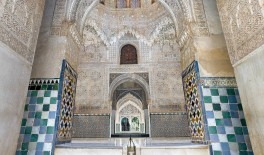The Alhambra of Granada
The art of architecture
RETURN
About the book the Alhambra of Granada
Designed in the 13th century to hold the court of the Nasrid Dynasty, the Alhambra of Granada is the only palatine city from the Islamic period that has remained practically intact until this day. Likewise, this unique site, declared a World Heritage Site by Unesco, constitutes the main testimony of Muslim presence on the Iberian Peninsula.
The epicentre of military and political power of the Kingdom of Granada, the Alhambra incorporated thoughout the centuries numerous palaces, gardens and defense elements to satisfy the necessities of successive residents. By doing so, the palatine city ended up converting into one of the most striking ensembles of the time, a reflection of the economic and cultural prosperity that the Nasrid Dynasty attained during the Middle Ages.
This photographic published by Dosde book covers in a visual way the various spaces that make up the Alhambra of Granada, at the same time as it provides complete information about the origins and the symbolic significance of elements such as the Court of the Lions, the Gate of Justice and the Alcazaba, icons of one of the zeniths in the history of Islamic architecture.
The epicentre of military and political power of the Kingdom of Granada, the Alhambra incorporated thoughout the centuries numerous palaces, gardens and defense elements to satisfy the necessities of successive residents. By doing so, the palatine city ended up converting into one of the most striking ensembles of the time, a reflection of the economic and cultural prosperity that the Nasrid Dynasty attained during the Middle Ages.
This photographic published by Dosde book covers in a visual way the various spaces that make up the Alhambra of Granada, at the same time as it provides complete information about the origins and the symbolic significance of elements such as the Court of the Lions, the Gate of Justice and the Alcazaba, icons of one of the zeniths in the history of Islamic architecture.
Photo Edition
The Alhambra of Granada
It includes exclusive digital content
Made with environmentally friendly paper
Official licensed product
Multilanguage: Available in 10 languages
About the book the Alhambra of Granada
Designed in the 13th century to hold the court of the Nasrid Dynasty, the Alhambra of Granada is the only palatine city from the Islamic period that has remained practically intact until this day. Likewise, this unique site, declared a World Heritage Site by Unesco, constitutes the main testimony of Muslim presence on the Iberian Peninsula.
The epicentre of military and political power of the Kingdom of Granada, the Alhambra incorporated thoughout the centuries numerous palaces, gardens and defense elements to satisfy the necessities of successive residents. By doing so, the palatine city ended up converting into one of the most striking ensembles of the time, a reflection of the economic and cultural prosperity that the Nasrid Dynasty attained during the Middle Ages.
This photographic published by Dosde book covers in a visual way the various spaces that make up the Alhambra of Granada, at the same time as it provides complete information about the origins and the symbolic significance of elements such as the Court of the Lions, the Gate of Justice and the Alcazaba, icons of one of the zeniths in the history of Islamic architecture.
The epicentre of military and political power of the Kingdom of Granada, the Alhambra incorporated thoughout the centuries numerous palaces, gardens and defense elements to satisfy the necessities of successive residents. By doing so, the palatine city ended up converting into one of the most striking ensembles of the time, a reflection of the economic and cultural prosperity that the Nasrid Dynasty attained during the Middle Ages.
This photographic published by Dosde book covers in a visual way the various spaces that make up the Alhambra of Granada, at the same time as it provides complete information about the origins and the symbolic significance of elements such as the Court of the Lions, the Gate of Justice and the Alcazaba, icons of one of the zeniths in the history of Islamic architecture.
Videos The Alhambra of Granada
Readers opinions
(2)
RETURN
Reviews
(2)
I loved the book, thank you.
I loved the photos and all the information in the book. I fully recommend it to get to know the Alhambra better.
Readers opinions
(2)
I loved the book, thank you.
I loved the photos and all the information in the book. I fully recommend it to get to know the Alhambra better.
Additional Information
- Additional Information
- Subtitle: The art of architecture
- Weight (g): 420
- Binding: Paperback with flaps
- Size (cm): 19,5 x 17,5
- Author: Dosde
- Pages: 0
- Edition: Photo Edition
The Alhambra, the history of an icon of Nasrid architecture
In a context of retreat with regard to the Muslim presence in the Iberian Peninsula, the last bastion of Islamic power was the Nasrid kingdom, which was founded by Muhammad I in 1232. The Sultan established in 1238 the headquarters of his court in Granada, building the great fortified enclosure of the Alhambra. Due to the refurbishments made by the following Nasrid sultans throughout the history of the Alhambra, the monumental complex became one of the most imposing royal cities of the time.
From the fifteenth century, the kingdom of Granada went through an era of instability and loss of territory, and after a harsh siege in 1492, Sultan Boabdil handed over the keys of the city to the Catholic Monarchs. They decided to keep the Alhambra site as a symbol of their victory, thus perpetuating the importance of a one-off monumental complex in the world.
The monumental complex includes exquisites palaces, mosques, gardens, schools and administrative dependencies of the time, in which very different architectural and artistic styles coexist. This diversity reflects the successive refurbishments that the Alhambra has undergone over time.
While the fortress of the Alcazaba stands out for its austere appearance in consonance with military use, the Nasrid palaces of the Mexuar, Comares and the Palace of the Lions are beautifully decorated, in accordance with their use by the Nasrid leaders. The coffered ceilings, the complex manufacturing process of the decorative tilework and the level of symbolic ornamentation convey the perfection achieved by Islamic architecture and Nasrid art.
After the conquest of Granada in 1492 by the Catholic Monarchs, the Christian period arrived at the Alhambra, during which successive refurbishment projects were carried out aimed at preserving the monumental complex. These additions also led to the construction of new units by Charles V, grandson of the Catholic Monarchs, equipped with a new, renewed architectural style.
From the fifteenth century, the kingdom of Granada went through an era of instability and loss of territory, and after a harsh siege in 1492, Sultan Boabdil handed over the keys of the city to the Catholic Monarchs. They decided to keep the Alhambra site as a symbol of their victory, thus perpetuating the importance of a one-off monumental complex in the world.
A visit to Granada's Alhambra
Located on the hill of Sabika, the Alhambra of Granada is the only Islamic palatine city that has remained almost intact to this day, and has established itself as a reference point of cultural interest in the city of Granada.The monumental complex includes exquisites palaces, mosques, gardens, schools and administrative dependencies of the time, in which very different architectural and artistic styles coexist. This diversity reflects the successive refurbishments that the Alhambra has undergone over time.
While the fortress of the Alcazaba stands out for its austere appearance in consonance with military use, the Nasrid palaces of the Mexuar, Comares and the Palace of the Lions are beautifully decorated, in accordance with their use by the Nasrid leaders. The coffered ceilings, the complex manufacturing process of the decorative tilework and the level of symbolic ornamentation convey the perfection achieved by Islamic architecture and Nasrid art.
After the conquest of Granada in 1492 by the Catholic Monarchs, the Christian period arrived at the Alhambra, during which successive refurbishment projects were carried out aimed at preserving the monumental complex. These additions also led to the construction of new units by Charles V, grandson of the Catholic Monarchs, equipped with a new, renewed architectural style.

























